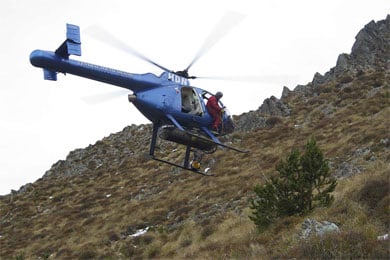Methods of control for wilding conifers
Introduction
Physical methods are the usual option to control wilding conifers.Helicopter use

Weed control by helicopter
Image: Peter Willemse ©
One of the biggest challenges of dealing with wilding conifers is often the remote and mountainous terrain in which they grow.
To cover a large area of scattered trees efficiently, helicopters are sometimes used to deliver people and tools to the trees.
Hand weeding
Small seedlings can be hand pulled or eased out of the ground with a tool. The smaller the seedlings are, the easier this is. Finding the seedlings is the main challenge but, once found, the control is straight forward. Volunteers are very useful for this work.
Shake the soil from the roots and place any available leaf litter over the site where the conifer has been pulled. Don't leave bare soil as this will encourage further conifer seeds to germinate.
Cutting
Medium size conifers can be cut down with loppers or an axe – most conifers will not regrow if all branches and needle formation below the cut are removed. If the stump is carefully cleared of all branches and needles, herbicide treatment of the stump may not be required.
Chain saw
Large size conifers can be felled with a chain saw. Felling wilding conifers rather than ring-barking is sometimes preferred for aesthetic and safety reasons.
Ring barking
Large size conifers can be ring barked. This method is an alternative to cutting down only when the trees will not cause a hazard to electricity lines or people when they finally fall. With a sharp chisel, axe or chainsaw make two deep parallel cuts into the sapwood right around the base of the plant.
Vigorous ring barking is required for conifers. Cuts should be no less than 5 cm apart and all the bark should be removed from between the cuts.
This method is not always successful as a callous may grow to heal the wound, or the plant may resprout from the base. Herbicide is sometimes applied to reduce the risk of regrowth.
Herbicide control
Herbicides are used to reduce the risk of regrowth from a cut stump or ring bark, and when wilding conifers are inaccessible or the stands are impenetrable.
Types of herbicide control:
- Ground basal bark application An oil-based herbicide designed to penetrate basal bark has been developed and offers advantages over foliar spraying and more labour intensive methods of delivering herbicide internally to the trunk (such as ring barking, frilling or “drill and fill”). The herbicide is applied as a wide collar around the trunk.
- Aerial basal bark application using a lance Helicopters are sometimes used to apply herbicide via a nozzle on a long lance. This method is particularly useful for covering trees spread widely across the high country and can be the only practical way to control trees growing on cliff-faces.
- Aerial foliar application using a boom When wilding conifer forests become dense and extensive, application of herbicide to foliage from the air becomes the only economic control method. Removing wilding conifers before they get to this stage is preferable.
Effective herbicide formulations to control wilding conifers are still under development.
Whenever herbicides are used, users are required to follow the instructions set by the Environmental Protection Authority and specified on the label. This includes wearing the specified protective clothing.
